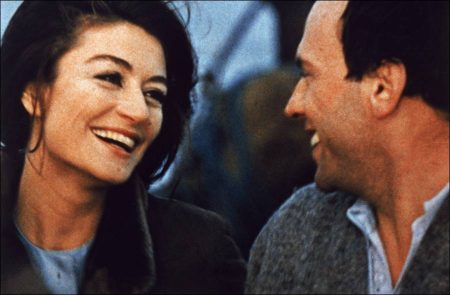A Man and a Woman movie storyline. Paris-based race-car-driver and widower Jean-Louis Duroc and movie-script supervisor and widow Anne Gauthier meet when they drop off their respective adolescent children, Antoine and Françoise, at their Deauville boarding school after their regular weekend outings. Despite being attracted to each other, they are guarded with each other, speaking as if their former spouses were still alive.
Initially, they spend time together in their weekend outings with their children. As they get to know each other, as their attraction grows, and as their true marital status comes to light, they each make calculated moves to advance their relationship, however slowly and cautiously each still is in this venture. However, each must overcome some emotional baggage, especially concerning their late spouses.
A Man and a Woman (French: Un Homme et une Femme) is a 1966 French film written and directed by Claude Lelouch and starring Anouk Aimée and Jean-Louis Trintignant. Written by Lelouch and Pierre Uytterhoeven, the film is about a young widow and widower who meet by chance at their children’s boarding school and whose budding relationship is complicated by the memories of their deceased spouses.[2] The film is notable for its lush photography, which features frequent segues among full color, black-and-white, and sepia-toned shots, and for its memorable musical score by Francis Lai.
A Man and a Woman had a total of 4,272,000 admissions in France and was also the 6th highest-grossing film of the year. In the United States, the film earned $14,000,000. The film won several awards, including the Palme d’Or at the 1966 Cannes Film Festival, two Golden Globe Awards for Best Foreign Language Film and Best Actress – Drama (for Aimée), and two Academy Awards for Best Foreign Language Film and Best Original Screenplay. A sequel, A Man and a Woman: 20 Years Later (Un Homme et une Femme, 20 Ans Déjà) was released in 1986, followed by The Best Years of a Life, which was released in 2019.

The ultimate “date” movie of the mid-1960s, director Claude Lelouch’s A Man and a Woman (Un Homme et Une Femme) stars Jean-Louis Trintignant and Anouk Aimee in the title roles. The twosome meet at the boarding school where their children are enrolled. Aimee, an actress, misses her train home, and Trintignant, a professional race car driver, offers her a ride.
It is the first of several friendly encounters which eventually blossom into love. Both want to commit to each other, but neither can shake the Past. The now-famous climactic scene in a train station was not scripted at the time of shooting, thus Aimee was unaware that director Lelouch had decided upon a tearful reunion between her and Trintignant. This explains the look of utter surprise on the actress’ face. Much has been written about the possible motivation behind Lelouch’s decision to film some scenes in color, others in black-and-white.
None of the more ardent auterists truly want to hear the director’s explanation: he’d run short of money halfway through production, and black-and-white film stock was infinitely cheaper. The winner of two Oscars (one for Best Foreign Film), A Man and A Woman also scored on the “top ten” with its memorable theme music by Francis Lai. A sequel, A Man and a Woman: 20 Years Later appeared….twenty years later.
According to director Claude Lelouch, the story originated from an experience following his disappointment trying to get a distribution deal for his film Les Grands Moments. As was his habit during troubling times, he went for a long drive and ended up on the shore at Deauville at 2:00 am. After a few hours sleep in the car, he was awakened by the sunrise and saw a woman walking on the beach with her daughter and a dog. This sparked his creativity which led to the story and script which he co-wrote with Pierre Uytterhoeven within a month.
A Man and a Woman (1966)
Directed by: Claude Lelouch
Starring: Anouk Aimée, Jean-Louis Trintignant, Pierre Barouh, Valérie Lagrange, Antoine Sire, Souad Amidou, Henri Chemin, Yane Barry, Simone Paris, Paul Le Person, Gérard Sire
Screenplay by: Pierre Uytterhoeven, Claude Lelouch
Production Design by: Robert Luchaire
Cinematography by: Claude Lelouch
Film Editing by: Claude Barrois, Claude Lelouch
Costume Design by: Richard Marvil
Makeup Department; Jacques Cousty, Denise Lemoigne
Music by: Francis Lai
MPAA Rating: None.
Distributed by: Allied Artists
Release Date: July 12, 1966
Views: 567



